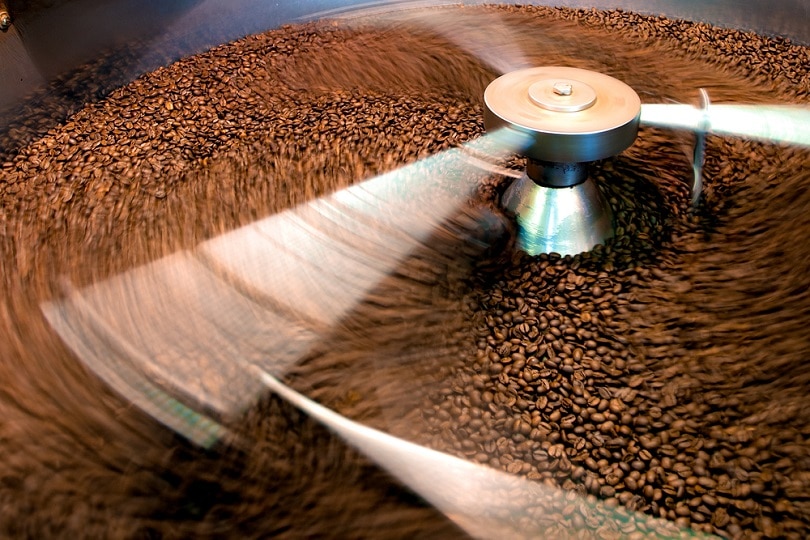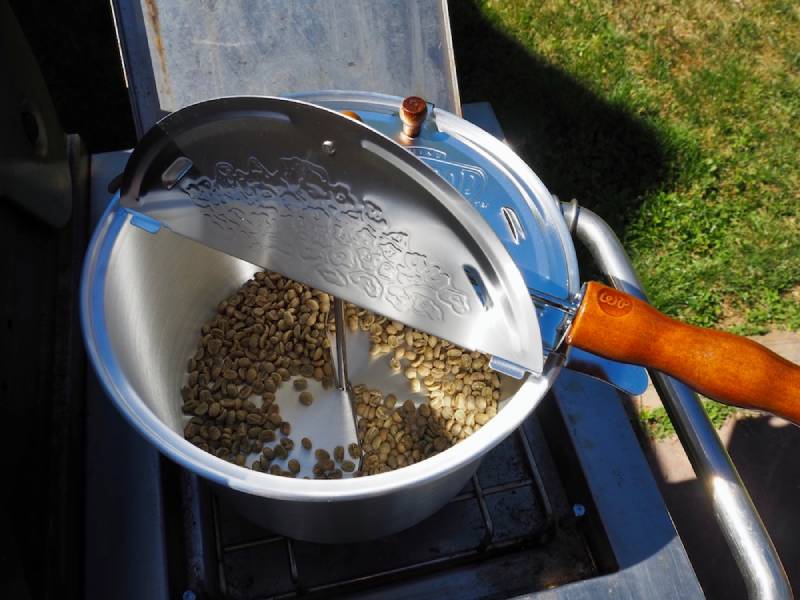
Have you ever smelled or tasted a green coffee bean? We have, and it’s not necessarily a smell or taste that makes you want to drink it. The enticing aroma that wafts through the air at coffee shops and during early mornings in your kitchen comes from roasted coffee beans. Most commercial roasters roast their beans in a large rotating drum that continuously stirs the beans to ensure they get heated evenly. However, there is another less common way to roast coffee: with hot air.
In this article, we discuss how some roasters use a novel air roasting method to produce more evenly roasted coffee in half the time it takes in a traditional drum roaster. We will also talk about why you, the consumer, should care about air roasting in terms of how your coffee tastes. Let’s begin!

How Do Coffee Drum Roasters Work?
Before we dive into talking about air roasters, we have to remind you how drum roasters work. Traditional drum coffee roasters are large rotating barrels that roast coffee by passing hot air through green coffee beans. Contrary to popular belief, contact with the metal drum isn’t the primary factor that roasts the beans; rather, it is the hot air that does the lion’s share of the work.
The drum rotates to ensure one side of a bean doesn’t have more exposure to the hot air and gets over-roasted. It typically takes anywhere from 15-20 minutes to roast one batch of coffee.

How Do Coffee Air Roasters Work?
Air roasters work in a completely different way with several advantages and some disadvantages compared to drum roasters.
Like drum roasters, air roasters also use hot air to roast coffee. However, instead of stirring the beans physically by rotating, air roasters float the beans over the bed of hot air that is doing the roasting. The beans naturally tumble and spin while they hover in the air and roast exceptionally evenly. Compared to drum roasters, air roasters roast much more evenly with less effort and engineering required.
Another advantage air roasters have over traditional barrel roasters is speed. A batch of coffee might take only 5-8 minutes in an air roaster, approximately half the time it takes in a regular roaster. For roasting businesses, this means a faster processing time and better scalability.

A Matter of Taste
These technical details are interesting, but what do they add up to for you, the coffee drinker? Quite a lot, actually. It turns out that air roasted coffee is less likely to have unpleasant bitter, burnt flavors because it has a built-in mechanism for removing unwanted residual material that comes off the coffee beans during a roast.
As coffee beans roast, the outer layer—called the chaff—cracks, and peels away from the bean. The chaff poses a problem for traditional drum roasters since they can burn if they aren’t removed. Burning chaff produces a lot of smoke which imparts a harsh flavor to the coffee.
Air roasters can easily remove the chaff during the roast since it is much lighter than the coffee beans. As the chaff breaks away from the beans, it is blown upward into a collection chamber where it won’t burn and ruin the batch.
Another advantage air roasters have over drum roasters is evenness and consistency. A tumbling bean in an air current will have all sides evenly exposed to hot air automatically; something drum roasters struggle with mightily. A more even roast means an easier brewing process for you and better-tasting coffee.
Consistency is another benefit that comes for free when you use an air roaster. Each batch will be virtually identical, with no special attention required. Drum roasters are notorious for being difficult to tune and for being finicky from batch to batch unless you have a top-of-the-line roaster worth tens of thousands of dollars.

Air-Roasted Coffee: Conclusion
The bottom line for consumers is air roasted coffee is more likely to be roasted perfectly every time than traditional drum-roasted coffee. If you’ve ever bought the same bag of coffee twice, only to be disappointed that the second bag wasn’t the same as the first, air-roasted coffee is worth trying.
If you’re a roaster or looking to start roasting coffee yourself, air roasters will be easier to use and let you make better coffee sooner. Even professional roasters could benefit from dabbling in air roasting if they’re looking to change things up. The primary drawback for industrial use is the capacity, which is usually much lower in air roasters than drum roasters.
RELATED READS:
- Light Roast vs Dark Roast Coffee
- Behind the Scenes: A Mesmerizing Coffee Roasting Video
- How To Roast Your Own Coffee at Home: 3 Different Methods
Featured Image Credit: SerhiyHorobets, Shutterstock















